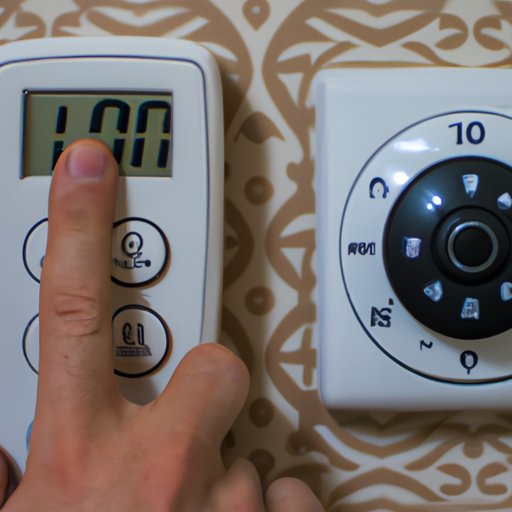Introduction
As summer approaches, many people are planning for their upcoming vacations. While packing suitcases and making travel arrangements, it can be easy to overlook an important detail: what to do with the thermostat when you’re away. Setting the thermostat correctly before leaving home can save energy and money, as well as ensure a pleasant return home. This article will provide helpful tips on setting the thermostat before a summer vacation in order to save energy, money, and have a pleasant return home.

Tips to Save Energy and Money When Away on Summer Vacation
When it comes to saving energy and money while away on vacation, there are several steps you can take. First and foremost, invest in a smart thermostat, such as the Nest Learning Thermostat or Ecobee SmartThermostat, both of which allow you to control the temperature from anywhere using your smartphone.
Additionally, you should set the temperature higher than normal when you’re away. According to the U.S. Department of Energy, “You can easily save energy while you’re away on vacation by setting your thermostat about 7°-10°F higher than your normal setting.” This can save up to 10% annually on cooling costs.
Another way to save energy and money is to unplug appliances. Unplugging electronics like televisions, computers, and microwaves can help reduce energy consumption while you’re away.
Finally, use fans to keep air circulating throughout the house. Ceiling fans can help make the house feel cooler without having to turn down the thermostat.
How to Set the Thermostat When You’re Away During Hot Weather
If you’re going away during hot weather, the best temperature to set your thermostat at is 82°F or higher. This is the recommended temperature for most households during the summer months.
If you have a smart thermostat, you can use it to adjust the temperature remotely. With a smart thermostat, you can easily turn up the temperature when you’re away and then turn it back down when you’re ready to come home. This can help save energy and money while you’re away.
It’s also important to keep doors and windows closed. If you leave any windows open, the hot air outside can affect the temperature inside your home and make your AC work harder.
What Temperature Should You Set Your Thermostat When You’re Away This Summer?
The recommended temperature to set your thermostat at when you’re away this summer is 82°F or higher. This is the ideal temperature for most households during the summer months.
However, it’s important to consider the climate of your home. If you live in a hot climate, you may want to set the temperature even higher. On the other hand, if you live in a cooler climate, you may be able to get away with setting the temperature lower.
The Right Way to Set the Thermostat Before a Summer Vacation
When setting the thermostat before a summer vacation, it’s important to adjust the temperature gradually. Don’t just suddenly turn the temperature up or down. Instead, make small adjustments over the course of a few days to give your AC time to adjust.
It’s also important not to turn off the AC completely. Turning off the AC can cause the temperature inside your home to rise quickly and create an uncomfortable environment when you return.
Don’t Let Your Home Get Too Hot: Setting the Thermostat Before Vacation
Before leaving for vacation, it’s important to make sure that you check the thermostat settings. Make sure that the temperature is set to the recommended 82°F or higher. This will help ensure that your home doesn’t get too hot while you’re away.
It’s also a good idea to have someone check on your home while you’re away. Having a friend or family member come by to check on the thermostat settings and make sure everything is in order can help prevent any unpleasant surprises when you come home.

Best Practices for Setting the Thermostat Before a Summer Vacation
When setting the thermostat before a summer vacation, here are some best practices to keep in mind:
- Set the temperature to 82°F or higher.
- Invest in a smart thermostat.
- Utilize fans.
- Unplug appliances.
- Have someone check on your home.
Don’t Come Back to an Unpleasant Surprise: Setting the Right Temperature Before a Summer Vacation
When setting the thermostat before a summer vacation, it’s important to adjust the temperature gradually. Don’t just suddenly turn the temperature up or down. Instead, make small adjustments over the course of a few days to give your AC time to adjust.
It’s also important not to turn off the AC completely. Turning off the AC can cause the temperature inside your home to rise quickly and create an uncomfortable environment when you return.
Finally, make sure to check the thermostat settings before leaving. Make sure that the temperature is set to the recommended 82°F or higher. This will help ensure that your home doesn’t get too hot while you’re away.
Conclusion
Setting the thermostat correctly before leaving home for a summer vacation can save energy, money, and ensure a pleasant return home. Here are the main tips to remember:
- Set the temperature to 82°F or higher.
- Invest in a smart thermostat.
- Utilize fans.
- Unplug appliances.
- Have someone check on your home.
Finally, don’t forget to invest in a smart thermostat. A smart thermostat can help save energy and money while you’re away and make it easier to adjust the temperature remotely.
(Note: Is this article not meeting your expectations? Do you have knowledge or insights to share? Unlock new opportunities and expand your reach by joining our authors team. Click Registration to join us and share your expertise with our readers.)
